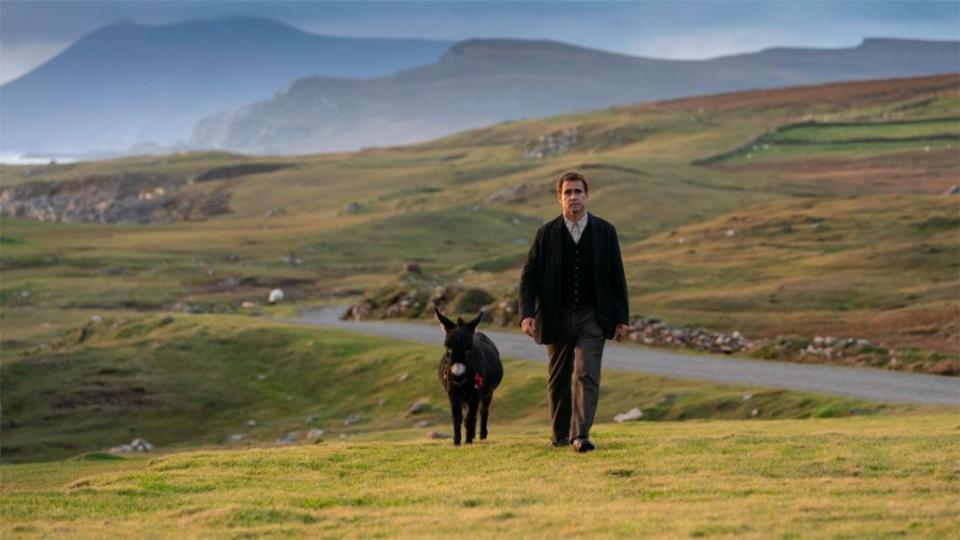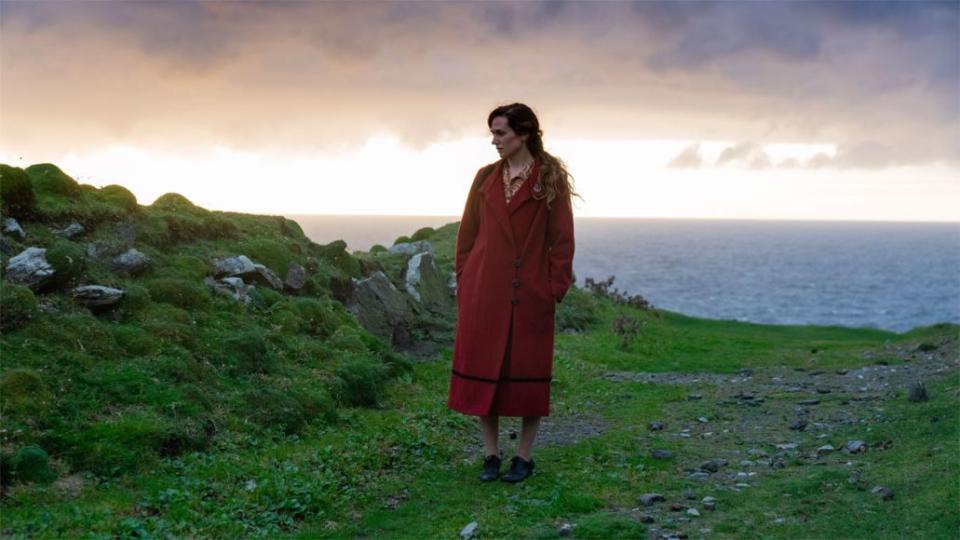The Banshees of Inisherin Is a Tender but Devastating Meditation on Male Friendship and Civil War: Review
- Oops!Something went wrong.Please try again later.
- Oops!Something went wrong.Please try again later.
- Oops!Something went wrong.Please try again later.
- Oops!Something went wrong.Please try again later.
The post The Banshees of Inisherin Is a Tender but Devastating Meditation on Male Friendship and Civil War: Review appeared first on Consequence.
The Pitch: Filmmaker and playwright Martin McDonagh had outlined a rough trilogy of plays called “The Aran Islands Trilogy.” The first two plays of the set, 1996’s The Cripple of Inishmaan and 2001’s The Lieutenant of Inishmore, were published and produced to major success, but the trilogy’s final play, The Banshees of Inisheer, never materialized. Now, 20 years later, McDonagh arrives once more with The Banshees of Inisherin — a work that does not necessarily serve as the trilogy’s final piece, but one that contains many of McDonagh’s literary and artistic motifs.
Born in England and raised by Irish parents, McDonagh has oft been in search of depicting the tragicomic aspects of Irish identity, with many of his plays and films taking place in Ireland and/or with an Irish cast. But even beyond these cultural staples, McDonagh has become lauded in the theater and film worlds for his sharp, idiosyncratic dialogue, his insular approach to storytelling, and his ability to juxtapose a type of light-hearted humanity with cruel, passionate acts of violence.
So it’s fitting that for McDonagh’s fourth film — the follow-up to his resoundingly successful Three Billboards Outside Ebbing, Missouri — he returns to the Aran Islands with The Banshees of Inisherin, a smaller, but similarly poignant tale. Taking place in 1923 on the small fictional island of Inisherin off the Irish coast, the film begins with local man Pádraic (played by Colin Farrell) as he strolls to the house of his best friend Colm (Brendan Gleeson) for their usual 2 p.m. happy hour. But, shockingly, Colm rejects Pádraic’s invitation, and suddenly ends their friendship.
Devastated and confused, Pádraic finds some support in his sister, Siobhán (Kerry Condon), as well as the town sheriff’s foolish young son, Dominic (Barry Keoghan), while Colm stubbornly requests a peaceful life free from Pádraic to continue playing his fiddle. But Pádraic refuses to accept Colm’s terms, leading to a significant rift between the two. Meanwhile, the Irish Civil War rages on the mainland, with McDonagh cleverly treating Pádraic and Colm’s conflict as an allegory to the fight happening beyond Inisherin’s quaint malaise.
Though The Banshees of Inisherin marks a major reunion between Farrell and Gleeson, both stars of McDonagh’s 2008 film, In Bruges, the tension that populates — and eventually destroys — their characters’ relationship is devastating. The film is surprisingly emotional; the conflict between Colm and Pádraic feels totally avoidable at the start of the film, but as we see glimpse after glimpse of each character’s stubbornness, their relatively simple conflict becomes a sharp wound that cements the film as a solemn tragedy.

The Banshees of Inisherin (Searchlight Pictures)
Natural Elegance: One of the most thoughtful choices of The Banshees of Inisherin comes in McDonagh’s treatment of the natural world as a foil to Pádraic and Colm’s conflict. Editor Mikkel E.G. Nelson does a phenomenal job of breaking up the film’s tense scenes by splicing in idyllic B-roll of Inisherin’s rolling hills, stunning seaside cliffs, and livestock.
Shot on location in Inishmore, each plain image re-centers the film on a kind of uninterrupted beauty and elegance, before giving way to more fraught scenes of emotional conflict. It serves as a blank slate for McDonagh and his characters to create within, but it’s one that represents the untainted beauty of Ireland before the Irish Civil War led to widespread devastation.
Even more fascinating is McDonagh’s positioning of animals in the film. Pádraic owns several livestock animals like horses and cows, but besides Colm, his favorite companion is a miniature donkey. Meanwhile, Colm lives alone with an adorable-but-unnamed border collie, whom Pádraic also loves. We frequently see Pádraic tending to his animals — he even demands that the donkey stay in the house while he grieves the loss of his friendship with Colm, to Siobhán’s dismay. But the film’s turning point rests on Pádraic’s fury when something happens to his donkey; in other words, the donkey is the final straw.
McDonagh not only depicts both Pádraic’s donkey and Colm’s dog as character representations of the two, but as symbols of our unquestionable kindness towards animals. Though they eventually become determined to hurt each other (physically or emotionally), Pádraic and Colm would never intentionally hurt each other’s animals. McDonagh’s point is that even these established rules of kindness become blurry in the acts of war; that war’s casualties always push further than intended.
Just Guys Bein’ Dudes: Another interesting way to look at Banshees in the context of McDonagh’s other work is through his depiction of men. The crux of the film lies in Pádraic’s inability to understand why Colm would shut the door on years of friendship — there is a deep, desperate need on Pádraic’s part to be validated and heard by Colm, who has realized, in short, that he actually doesn’t need Pádraic to cope with his own existential conflict. Instead, Colm looks to music to free him from his existential dread, telling Pádraic that the severing of friendship is due to his desire to spend the rest of his life on Inisherin in service of art and “peace.”
It’s Pádraic’s fundamental resistance to change that leads to carnage, similar to war. But it’s also about men without any emotional framework or infrastructure, men who rely on bonds like theirs to survive. Colm’s rejection of that bond is perhaps meant to teach Pádraic a lesson — or rather, to encourage a solitary but colorful life free from the logical trap of sameness. Meanwhile, the loss that Pádraic feels does not cause him to seek out empty relationships with women to fill the void; in fact, that’s not even an option for Pádraic. It just hurts.
McDonaugh knows that it’s not enough to make a film that says “men can feel things too.” Instead, he does a brilliant job of exploring the way that men can turn to violence — or in Colm’s case, self-mutilation — because of the way those feelings of loss, rejection, or dread can mutate. McDonagh has explored this before with Farrell and Gleeson’s characters in In Bruges, but perhaps his 2012 film Seven Psychopaths was a more bombastic investigation of the messes that men can make, where collective carnage from its male cast is inseparably tied to the completing of a character arc.
But these films were also about men that need each other desperately, and the emotional bonds that tie them together come from these gaping holes of insecurity. The Banshees of Inisherin is certainly McDonagh’s most comprehensive look at the ties that bind men together, and with a backdrop of civil war, the emotional battle is what is primarily fought in Inisherin.

The Banshees of Inisherin (Searchlight Pictures)
The Verdict: In Banshees, Colm’s rejection of a man who deeply needs him is, frankly, infuriating. Understandable? Certainly. Intentionally cruel? Certainly not. And yet, the ramifications of this decision are disastrous, because Pádraic lacks the capacity to truly recognize Colm’s intentions. It’s no longer a question of communication — Colm’s repeated attempts to sever contact with Pádraic are humiliatingly clear. It’s about the cost of losing purpose, that if Pádraic must suffer because of Colm’s quest for peace, then Colm must not be granted peace.
As an allegory to civil war, it’s well-worked and deeply thoughtful. But overall, the film leaves a slightly bitter taste, and — perhaps purposely — lacks some of the final third conviction that McDonagh has achieved so often in his stage and film work. Perhaps the largest adjustment from McDonagh, however, is the actual lack of violence in the film. For a director and writer who has explored a type of “ultra-violence” to create more compelling contrasts in his characters, The Banshees of Inisherin is undoubtedly his most restrained effort yet, opting instead for a more emotional and psychological conflict than a physical one.
This adjustment creates a deeper emphasis on the quiet solitude of McDonagh’s work and the slow-burning tension that loss facilitates, and it gives his astonishingly good cast more room to roam emotionally. Farrell, Gleeson, and Condon are at an all-time high in Banshees, and it’s a treat to relish in their multi-dimensional performances. The film may be a solemn one, but there are plenty of beautiful truths that McDonagh and his cast and crew uncover on the fictional island of Inisherin.
Where to Watch: The Banshees of Inisherin hits theaters on Friday, October 21st.
Trailer:
The Banshees of Inisherin Is a Tender but Devastating Meditation on Male Friendship and Civil War: Review
Paolo Ragusa
Popular Posts
Blink-182's Tom DeLonge, Mark Hoppus, Travis Barker Reunite for World Tour and New Music
Aubrey Plaza "Freaked Out" Robert De Niro: "I Did Some Questionable Things"
M. Shadows Admits Avenged Sevenfold "Cut a Little Too Close" to Metallica on Hail to the King
George Floyd's Family Considering Lawsuit Against Kanye West for Defamation
M.I.A. Questions Why Alex Jones "Pays for Lying" But Not "Celebrities Pushing Vaccines"

